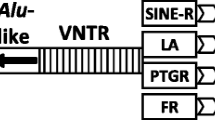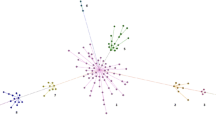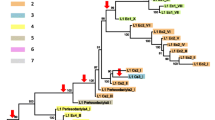Abstract.
Sequence analysis of a 237 kb genomic fragment from the central region of the MHC has revealed that the HLA-B and HLA-C genes are contained within duplicated segments peri-B (53 kb) and peri-C (48 kb), respectively, and separated by an intervening sequence (IF) of 30 kb. The peri-B and peri-C segments share at least 90% sequence homology except when interrupted by insertions/deletions including Alu, L1, an endogenous retrovirus, and pseudogenes. The sequences of peri-B, IF, and peri-C were searched for the presence of Alu elements to use as markers of evolution, chromosomal rearrangements, and polymorphism. Of 29 Alu elements, 14 were identified in peri-B, 11 in peri-C, and 4 in IF. The Alu elements in peri-B and peri-C clustered phylogenetically into two clades which were classified as ``preduplication'' and ``postduplication'' clades. Four Alu J elements that are shared by peri-B and peri-C and are flanked by homologous sequences in their paralogous locations, respectively, clustered into a ``preduplication'' clade. By contrast, the majority of Alu elements, which are unique to either peri-B or peri-C, clustered into a postduplication clade together with the Alu consensus subfamily members ranging from platyrrhine-specific (Spqxcg) to catarrhine-specific Alu sequences (Y). The insertion of platyrrhine-specific Alu elements in postduplication locations of peri-B and peri-C implies that these two segments are the products of a duplication which occurred in primates prior to the divergence of the New World primate from the human lineage (35–44 mya). Examination of the paralogous Alu integration sites revealed that 9 of 14 postduplication Alu sequences have produced microsatellites of different length and sequence within the Alu 3′-poly A tail. The present analysis supports the hypothesis that HLA-B and HLA-C genes are products of an extended segmental duplication between 44 and 81 million years ago (mya), and that subsequent diversification of both genomic segments occurred because of the mobility and mutation of retroelements such as Alu repeats.
Similar content being viewed by others
Author information
Authors and Affiliations
Additional information
Received: 21 May 1997 / Accepted: 9 July 1997
Rights and permissions
About this article
Cite this article
Kulski, J., Gaudieri, S., Bellgard, M. et al. The Evolution of MHC Diversity by Segmental Duplication and Transposition of Retroelements. J Mol Evol 45, 599–609 (1997). https://doi.org/10.1007/PL00006264
Issue Date:
DOI: https://doi.org/10.1007/PL00006264




